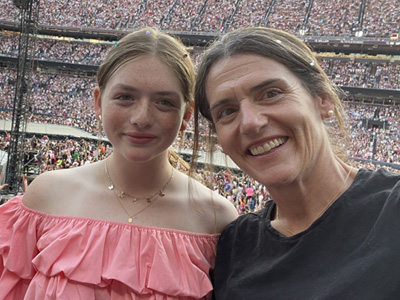Stella’s Nerves of Steel
From heartache to heartfelt, finding community and connections has made all the difference for this teen with juvenile arthritis and her family.
“When she started walking soon after,” says Amanda, “she was walking pigeon-toed. We took her to an orthopedist who advised us to put her in high-top shoes, which didn’t really help.”
When Stella was 5, things came to a head. An Easter egg hunt had left Stella barely able to walk the next day and it kept her from enjoying other activities, too. Even limiting playtime in the backyard to release ladybugs led to Stella walking with even more difficulty. Amanda admits feeling frustrated by what was happening to her daughter. Only a few days later, Stella was getting ready for soccer when everything really changed.
“We were running late,” says Amanda, “so I was hurrying her along, and she was like ‘Mom, my knee kind of hurts.’ Her knee was the size of a football. We went straight to the pediatrician who had Saturday hours, and the pediatrician immediately said, ‘This looks like juvenile arthritis.’”
Amanda couldn’t believe it.
“I said, ‘Kids don't get arthritis.’ I was in total denial, not wanting to hear any of it,” Amanda admits. They went to another pediatrician who told them the same thing — Stella has juvenile arthritis (JA) — and advised them to go to Children’s Healthcare of Atlanta to rule out any infections. There, Stella tested positive for rheumatoid markers and was referred to a rheumatologist.
Stella was quickly put on and then taken off methotrexate when it caused her to feel sick and proved less than effective. A biologic, etanercept (Enbrel), was then prescribed — as an injectable, which made it a challenge to get young Stella to take it.
“Stella would barricade herself in the closet and we’d chase her around. We tried bribes,” Amanda says. “We did everything we could to get her to be willing to do it.”
Eventually, Amanda and her husband resorted to "yes days” — days dedicated to saying, “yes,” to Stella’s every request — just to soften the sting of shot days. “I had to say yes to anything she asked for on the shot day, and mostly that would entail eating fast food three times a day and then we’d go to the Zoo or the aquarium, or some local animal-related activity,” Amanda explains. “As she got older, the yes days morphed into more obscure things like going fishing. One time we climbed Stone Mountain. And you know, when you're 6 and 7 years old, there's only so many things you can think of.”
JA Camp Changed Everything
Around the time of Stella’s diagnosis, Amanda heard about the Arthritis Foundation through the pediatric rheumatologist and the support and resources it provides to JA families. Inside the JA Power Pack they received at their doctor visit, they found information about Camp Twin Lakes and Camp Ache Away. This local JA Camp provided an opportunity for the family to meet and connect with other families who were dealing with JA.
“It had horseback riding, archery, canoeing and all these fun camp activities,” says Amanda. “The kids are like, ‘We want to go! We want to do this.’ And I didn't know anything about it, and I looked at it. And I was thinking like, ‘Oh, boy.’”
“The Arthritis Foundation has given us a family and network of people who you don't have to say anything, and they know. That connection and that comfort knowing they get you, even if you don't say a word is very valuable.”
— Amanda, JA mom“My coaches — I think they try not to show it, but I do think they watch me a little closer because I know that I'm not going to tell them that I want to be taken out,” Stella says with a laugh.
“She doesn't get nervous,” Amanda shares with pride. “She doesn't get scared. She doesn't get flustered. You know, on her middle school team, they're like, ‘Oh, no, we need a pitcher.’ She's like, ‘I'll pitch.’ She never pitched before. She goes out there and strikes everyone out. She obviously has an ability, but I think a lot of it is she's got nerves of steel. We joke that she has ice running through her veins, but I think a lot of it is because she's been through so much.”
Stella’s nerves of steel have also served her well as she has shared her story, along with Amanda, during the Arthritis Foundation Advocacy Summit. “Most people don't know that kids can get arthritis,” Amanda says. “I think it changes people's perspectives because they see that this kid looks normal. But she wouldn't look normal if it wasn't for the medicines. I think it's about visibility and kind of getting the word out and awareness. And I think the Arthritis Foundation is a great platform for that.”
Deepening Arthritis Community Connections
Amanda currently serves on the national board of directors for the Arthritis Foundation and is so grateful for connecting with the organization when they did.
“The Arthritis Foundation has given us a family and network of people who you don't have to say anything, and they know. We see them at the Foundation events, but we also run into them at the hospital, at the doctor's office and at physical therapy. We're all kind of traveling in the same circles, and to have that connection and that comfort knowing they get you, even if you don't say a word is very valuable.”
Amanda shared the most valuable piece of advice she got from a fellow parent: “You really have to celebrate the small stuff because you don't know what tomorrow's going to bring. So, no matter how small your win is, you have to celebrate it, and I think that's a great lesson for life.”
To find support online, visit the Arthritis Foundation’s Live Yes! Connect Groups. There are groups dedicated to JA families.
Story of Yes
Say Yes! Share Your Story
One of the most powerful things you can do to help others living with arthritis is share your story. If you have arthritis, care for someone who does or are making an impact in the arthritis community, your experiences can help someone who may feel alone. Whether you're a patient, caregiver, donor, volunteer or researcher — you can be an inspiration by sharing your Story of Yes.
Share Your StoryStay in the Know. Live in the Yes.
Get involved with the arthritis community. Tell us a little about yourself and, based on your interests, you’ll receive emails packed with the latest information and resources to live your best life and connect with others.

 It seemed odd that Amanda’s daughter, Stella, would have a crooked finger when she was a toddler. So much so that they took her to a hand specialist who put her finger in a splint. The splint didn’t last, but it was just the start.
It seemed odd that Amanda’s daughter, Stella, would have a crooked finger when she was a toddler. So much so that they took her to a hand specialist who put her finger in a splint. The splint didn’t last, but it was just the start.  “My coaches — I think they try not to show it, but I do think they watch me a little closer because I know that I'm not going to tell them that I want to be taken out,” Stella says with a laugh.
“My coaches — I think they try not to show it, but I do think they watch me a little closer because I know that I'm not going to tell them that I want to be taken out,” Stella says with a laugh.